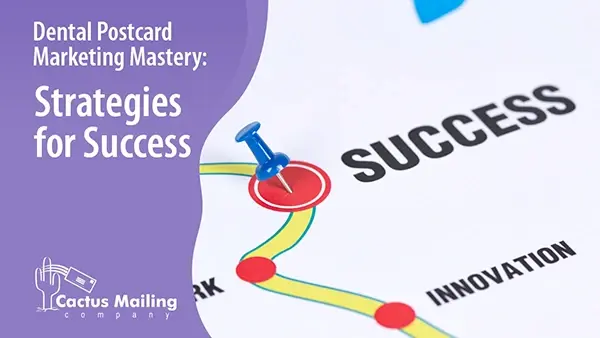We Are Here to Help!
What to Expect from Us:
No Pressure, Just Service!
Get no obligation pricing details and strategies that will work for your business.
Postcard marketing is a tried and tested strategy in the world of advertising that connects businesses with a target audience using promotional print pieces, such as coupons, event announcements, and special offers. It involves sending physical postcards through direct mail, making it an effective marketing tool to reach customers who may not rely heavily on digital channels such as email and social media. In today's fast-paced marketing landscape, postcard marketing serves as a valuable approach for businesses seeking a tangible method to engage potential and existing customers.
When planning a postcard marketing campaign, it's crucial to identify a specific marketing goal right from the beginning, such as increasing sales, generating leads, or building brand awareness. By understanding the overarching objective, businesses can develop tailored content that resonates with their intended audience, resulting in increased conversion rates and a higher return on investment.
Though postcard marketing might seem like a traditional method, it continues to prove its worth as many companies successfully integrate it into their multi-channel marketing strategies. With a clear understanding of the target audience, a well-defined direct marketing goal, and compelling content, postcard marketing can effectively enhance the reach and impact of a company's promotional efforts.
Defining Your Brand and Message
The focus of postcard marketing should be on establishing a clear and consistent brand message that grabs the recipient's attention. This includes recognizing the importance of design and visual appeal in the postcard, as well as tailoring the message to resonate with the target audience.
Crafting a Consistent Brand Message
A consistent brand message ensures that your postcard mailing conveys the same core values and benefits of your products or services. To achieve that:
- Define your goals: Determine the purpose and message of the postcard, such as creating awareness, generating leads, or promoting an offer.
- Identify your target audience: Understand the demographics and preferences of the audience you want to reach.
- Craft a compelling message: Create a clear and concise message that highlights the main benefits or features of your offering.
Remember, a strong brand message is essential for successful postcard marketing.
Aligning Design with Brand Identity
Striking the right balance between design and brand identity helps create a consistent postcard that aligns with your audience's expectations. Here are the steps to align postcard design with brand identity:
- Brand Recognition
Include key brand elements on your custom postcard such as logos and taglines to aid in recognition and reinforce your brand identity by creating a lasting impression in the minds of new customers.
- Consistent Visual Elements
Use your brand’s colors, fonts, and logo across all materials, including direct mail postcards, maintaining a consistent look. Emphasize important points using bold or italic text styles.
- Simple, Reader-Friendly Layout
Ensure the layout is easy to read and uncluttered. Organize content into smaller sections for better readability, keeping the message clear and straightforward.
- Relevant and Attractive Imagery
Incorporate eye-catching images or graphics that reflect your brand and message, enhancing visual appeal and making the postcard mailer more engaging.
By following these guidelines, you'll create a cohesive postcard marketing campaign that reflects your brand's identity and effectively communicates your message to the target audience.

Establishing Your Target Audience
Understanding your audience's demographics and interests is essential for effective postcard marketing. Learn how to build and segment your mailing list based on these insights. This section will provide the steps to create a focused and successful direct mail strategy.
Identifying Demographics and Interests
When it comes to postcard marketing, the first step in creating a successful campaign is establishing your target audience. Understanding the demographics and interests of your audience allows for a more effective and tailored marketing approach. Demographics include factors such as age, gender, income, and location, whereas interests could involve hobbies, lifestyle choices, and shopping preferences. To gain insights about your existing customers, analyze purchase behavior and interaction with past campaigns.
For potential customers, market research and competitor analysis can help identify patterns and interests relevant to your products or services. Tailoring your postcard design and messaging to appeal to your target audience will increase the likelihood of engagement and response rates.
Building and Segmenting Your Mailing List
Once you've identified the demographics and interests of your target audience, it's crucial to build and segment your mailing list. Segmentation involves categorizing your targeted mailing list into smaller groups based on shared demographics or interests. This allows you to create targeted marketing materials that speak directly to the needs and desires of each segment, resulting in a more personalized and effective campaign.
There are several segmentation methods you can use, such as:
- Geographic: based on location, region, or proximity to your business.
- Demographic: based on age, gender, income, or education level.
- Psychographic: based on lifestyle, values, or interests.
- Behavioral: based on purchasing behavior or past interactions with your campaigns.
Building and maintaining a well-curated mailing list ensures you're reaching the right audience with your targeted marketing efforts, ultimately leading to a greater return on investment in your postcard marketing campaigns. Keep in mind that the more accurate and up-to-date your mailing list is, the better results you're likely to achieve.
Crafting Effective Postcard Design
An effective postcard design combines art, graphics, and illustrations to catch the attention of recipients. A good design follows certain best practices, such as using a clear and bold font, the right postcard size, and leaving appropriate white space for a balanced appearance. Branding elements should be incorporated, including consistent colors and logos. It is crucial to use eye-catching images that convey your marketing message effectively and resonate with your target audience.
Balancing Creativity and Clarity
While it's essential to create a visually appealing postcard, it's also important to prioritize clarity and communication. Overusing graphics and illustrations can make your postcard look cluttered and obscure the key message. Maintain a balance between creativity and clarity by carefully planning the layout, using appropriate colors, and incorporating useful design elements that don't distract from your message. White space can help you achieve this balance by keeping your design clean and drawing the reader's eye to the most important parts.
Compelling Copy and Call-to-Action
A captivating copy is essential for a successful postcard marketing campaign. Use concise, powerful language that highlights the benefits of your product or service. Powerful words can evoke emotions and encourage readers to take action. Your copy on the printed postcard should be informative, engaging, and written from a third-person perspective to establish a professional tone.
To capture the reader's interest and motivate them to take the next step with your brand, use a combination of the following for your direct mail marketing campaign:
Crafting an Engaging Headline
- Select words that immediately grab the reader's attention and pique their curiosity.
- Keep it short and impactful to be more memorable and effective.
- Your headline should hint at the value or benefit the reader will gain from your product or service.
Writing the Body Copy
- Focus on how your product or service can solve the reader's problems or improve their life.
- Use bullet points to make the information more digestible and easier to scan.
- Use a storytelling style to create a more relatable and engaging message.
- Add social proof like customer testimonials or relevant statistics to enhance credibility.
Developing a Strong Call to Action (CTA)
- Your CTA should clearly state what you want the reader to do next.
- Phrases like "Act now" or "Limited time offer" can motivate immediate action.
- The CTA should stand out. Make it visually distinct from the rest of the copy, possibly through buttons or other graphic elements.

Logistics and Execution
Choosing the right printing and mailing services and timing your postcard campaigns correctly are vital steps in your direct mail marketing. Let's explore how to select the best partners for printing and mailing, and how to schedule your campaigns for the best results.
Selecting the Right Postcard Printing and Mailing Services
When planning a direct mail campaign, it is essential to choose the right postcard printing service and postcard mailing service to ensure a successful outcome. Look for a company that offers cost-effective solutions, high-quality printing, and a variety of postcard paper stock options. A reputable provider should also guide you on how to optimize this traditional mailing method and significantly improve response rates.
Some factors to consider when selecting the right service include:
- Postcard printing quality: High-quality print is crucial for your postcard to stand out and capture the attention of your target audience.
- Paper stock options: The weight, texture, and finish of the postcard paper stock can impact the overall look and feel of your direct mail postcards.
- Mailing services: Efficient and accurate mailing services are essential for timely delivery and optimal response rates.
Timing and Scheduling Campaigns
Proper timing and scheduling of your postcard campaigns are vital for maximizing the effectiveness of your direct mail postcard efforts. Typically, planning and preparation should commence one to two months before the targeted campaign release to ensure ample time for design, content creation, and logistical arrangements. Here are some critical aspects to consider when planning your campaign timing:
- Seasonality: Align your campaigns with seasonal trends or events relevant to your target audience to increase the likelihood of positive engagement.
- Recurring postcard campaigns: Schedule recurring campaigns to maintain brand visibility and consistently remind the audience of your unique offers.
- Deadline-driven promotions: If your campaign includes time-sensitive offers, such as discounts or limited-time deals, ensure the postcards are delivered well ahead of the deadline to allow recipients adequate time to act on the promotion.
Measuring Success and ROI
To truly understand the impact and value of your postcard marketing campaign, it's crucial to measure its success and return on investment (ROI). But how do you quantify the effectiveness of your direct mail efforts? The answer lies in analyzing the right direct mail metrics. It's important to regularly test and track the campaign's performance through unique codes, QR codes, or URLs to understand its effectiveness and refine future strategies.
For a comprehensive guide on how to effectively measure and interpret these metrics, visit our detailed blog post: Direct Mail Metrics: Your Guide to Measuring Success. Here, you'll find expert advice and practical tips to help you navigate through the complexities of direct mail analytics, ensuring your marketing efforts are not just creative, but also result-driven and profitable.
Follow Up Strategy
Once your postcard has reached your audience, it's crucial to reinforce your marketing message and strengthen brand recall through a follow-up strategy. Incorporating a well-planned follow-up strategy into your postcard campaign can significantly increase its effectiveness, turning a single touchpoint into a comprehensive, multi-channel engagement that drives brand recall and ROI. Here's how:
Planning the Follow-up: Develop a simple follow-up plan after your postcard campaign to continue the conversation and offer more value based on your initial message.
Using Multiple Channels: Use different channels like email and social media for follow-up. Emails can reinforce your postcard's message, while social media keeps your brand active in the audience's mind. Make sure all content is consistent with your postcard campaign.
Boosting Brand Recall: The goal is to make your brand more memorable. Every follow-up interaction should remind the audience of your brand, using consistent branding and messaging. Encourage them to engage more, be it through a purchase, newsletter sign-up, or social media interaction.

Conclusion
Postcard marketing is a powerful and cost-effective way to amplify your brand's awareness and reach out to potential customers. With some careful planning, creative design, and the right message, you can use postcard marketing to drive sales and increase your bottom line. So, take action today and start creating postcards that will make an impact on your audience.
Our postcards have helped various businesses get leads, boost brand awareness, and grow revenue. Let us help you create a marketing postcard design that can achieve your marketing goals!

 Mike Ryan: Jan 22, 2024
Mike Ryan: Jan 22, 2024



 Joe McAtee
Joe McAtee